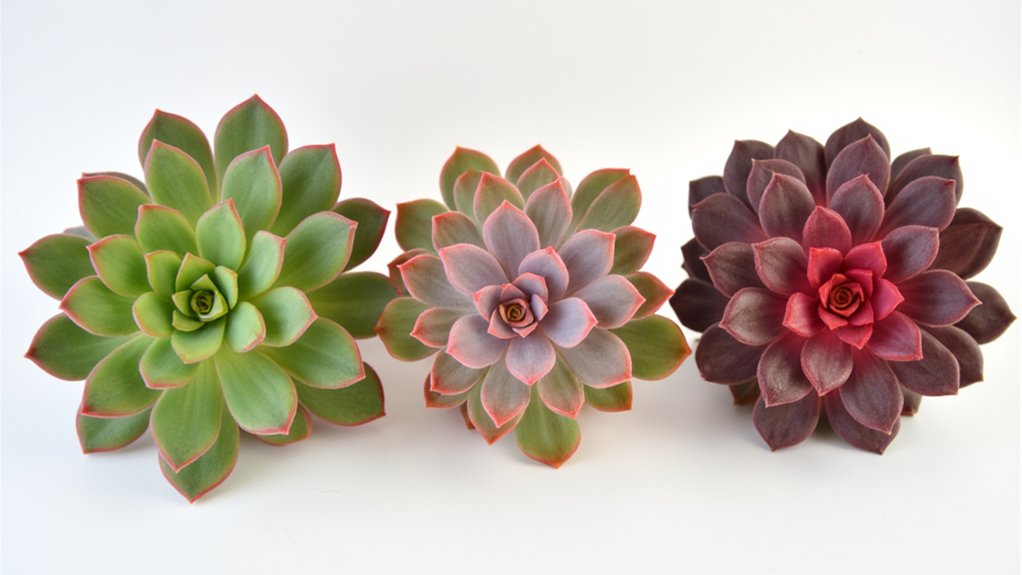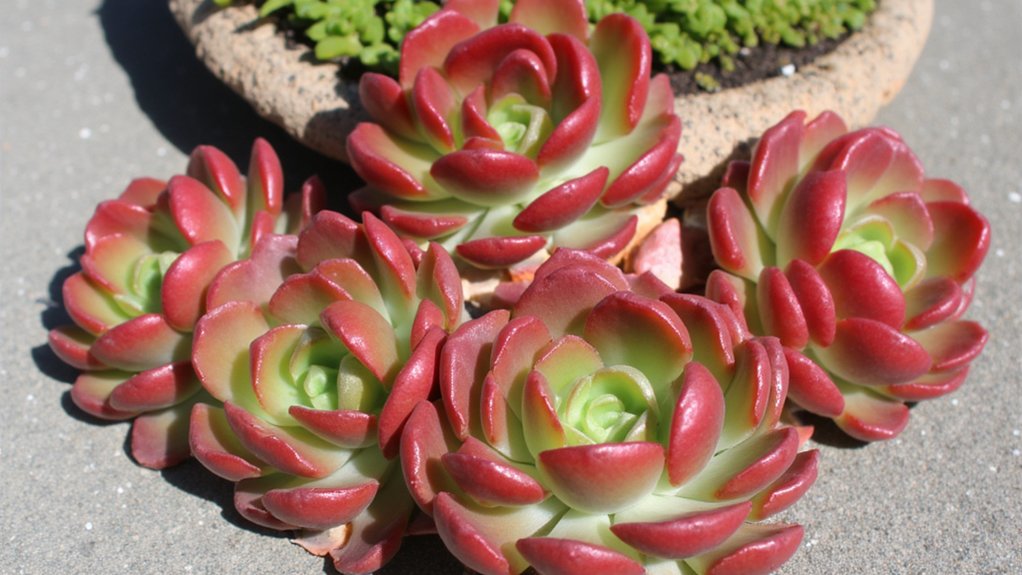You’ve likely noticed your succulents displaying surprising new hues, from subtle pink edges to deep purple leaves. These color transformations aren’t random – they’re actually your plants’ sophisticated response to environmental changes. While many gardeners worry these shifts signal trouble, they’re often natural survival mechanisms that protect the plant. As you explore the science behind these changes, you’ll discover how to safely encourage these vibrant displays in your own collection.
Contents
- 1 The Science Behind Succulent Color Changes
- 2 Common Environmental Triggers for Color Transformation
- 3 Light Exposure and Its Impact on Pigmentation
- 4 Temperature’s Role in Succulent Coloration
- 5 Seasonal Color Changes Throughout the Year
- 6 Purposely Stressing Plants for Vibrant Colors
- 7 Maintaining Health While Encouraging Color Changes
The Science Behind Succulent Color Changes

Color changes in succulents arise from complex biochemical processes triggered by environmental stressors and seasonal shifts. When your succulent experiences stress, it produces pigments called anthocyanins and carotenoids as a protective response, much like how you’d put on sunscreen before heading outdoors.
During this process, you’ll notice your plant’s chlorophyll (the green pigment) becoming less dominant, allowing other colors to shine through. These include reds, purples, and yellows, which help shield the plant’s sensitive tissues from excessive sunlight, temperature changes, or drought conditions. It’s your succulent’s natural survival mechanism at work.
Common Environmental Triggers for Color Transformation

While your succulent’s transformation can occur naturally with seasonal changes, several environmental factors directly trigger these striking color shifts.
Direct sunlight exposure often causes the most dramatic changes, with succulents developing red, purple, or orange stress coloring within 1-2 weeks. Temperature fluctuations, especially when nights dip below 55°F, can trigger similar responses.
Reduced watering schedules, allowing soil to dry completely between waterings, may intensify your plant’s colors within 10-14 days. Nutrient availability also plays a role – phosphorus deficiency often results in purple-tinted leaves, while nitrogen scarcity can produce reddish hues.
Light Exposure and Its Impact on Pigmentation

Among all environmental factors, light plays the most significant role in your succulent’s pigmentation changes. When exposed to bright, direct sunlight, your plants will produce protective pigments called anthocyanins and carotenoids, resulting in stunning reds, purples, and oranges.
You’ll notice these changes occurring gradually over 2-4 weeks, particularly at the leaf tips and edges. The transformation typically starts when your succulent receives 6+ hours of direct sunlight daily, though some species may need up to 8 hours for full color development.
Be careful not to rush this process, as sudden exposure can cause sunburn. Instead, increase light exposure by 30 minutes daily.
Temperature’s Role in Succulent Coloration
Temperature fluctuations create dramatic changes in your succulent’s coloring, especially during seasonal shifts. When temperatures drop below 50°F (10°C), many varieties develop richer reds and purples as they produce protective anthocyanin pigments. This stress response helps shield the plant from cold damage.
During summer heat, you’ll notice your succulents might fade to paler shades or develop a whitish coating. This natural adaptation, occurring above 85°F (29°C), reflects excess sunlight and prevents leaf burn. Some species, like Sempervivum, will cycle through multiple color changes as temperatures swing between seasons.
To maintain vibrant colors, keep your succulents within their ideal temperature range of 60-75°F (15-24°C).
Seasonal Color Changes Throughout the Year
As your succulent progresses through the year’s changing seasons, you’ll notice predictable shifts in its color palette. During spring growth, most varieties display their brightest green hues, while summer’s intense light often triggers protective pigments, resulting in reds and purples.
Fall brings deeper, richer tones as days shorten and temperatures drop. You’ll see burgundies and bronze colors intensify, especially in varieties like Sedum and Echeveria. Winter dormancy typically produces the most dramatic transformations, with many succulents developing blue-gray waxy coatings and muted pastels to protect against cold and frost.
Purposely Stressing Plants for Vibrant Colors
Many succulent enthusiasts deliberately stress their plants to achieve stunning color variations, though it’s essential to do this carefully and gradually. You’ll need to expose your plants to specific conditions that trigger color changes without causing harm.
To intensify reds and purples, place your succulents in bright, indirect sunlight for 4-6 hours daily, then gradually increase exposure over two weeks. Reduce watering to once every 10-14 days, allowing soil to dry completely between sessions.
Temperature fluctuations between 55-75°F can enhance blues and purples. Just remember, while stress brings out vibrant hues, you shouldn’t let your plants experience extreme conditions for extended periods.
Maintaining Health While Encouraging Color Changes
While achieving vibrant colors through stress can be visually appealing, you’ll need to carefully monitor your succulent’s overall health during the process. Watch for signs of excessive stress like shriveled leaves, brown spots, or mushy stems, which indicate you’ve pushed too far.
Maintain a balance by providing adequate water every 7-10 days, even during color-inducing stress periods. When you notice new growth slowing considerably or leaves becoming papery-thin, it’s time to ease up on the stress factors.
You can’t rush the color transformation – allow 2-3 weeks for changes to develop while ensuring your plant retains 75% of its normal watering schedule.
